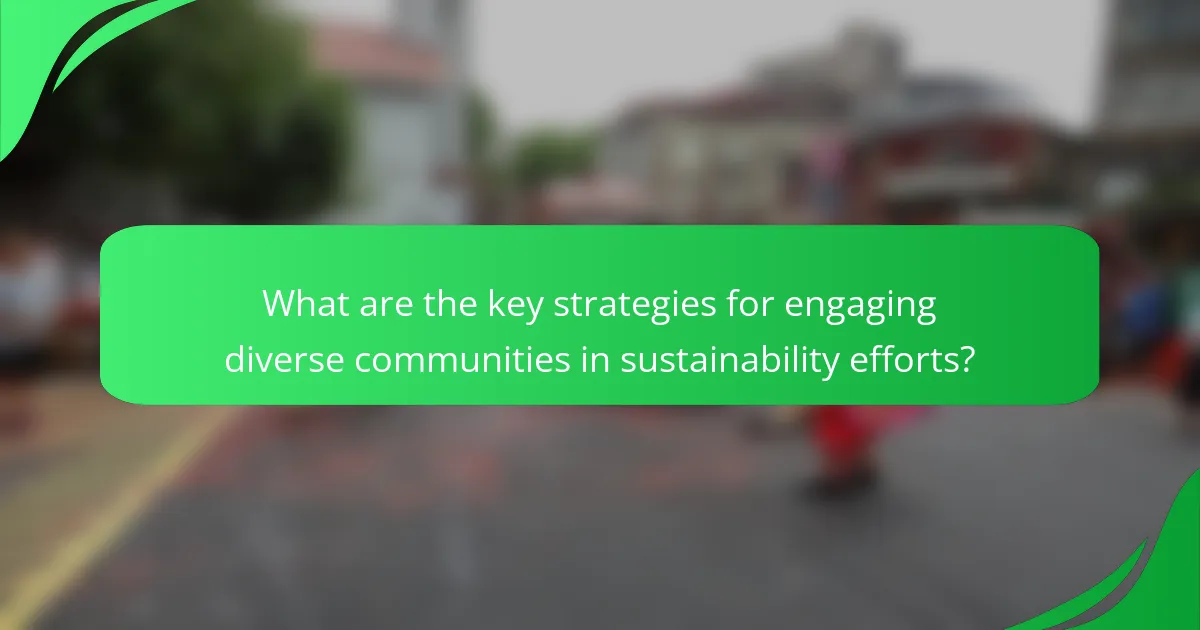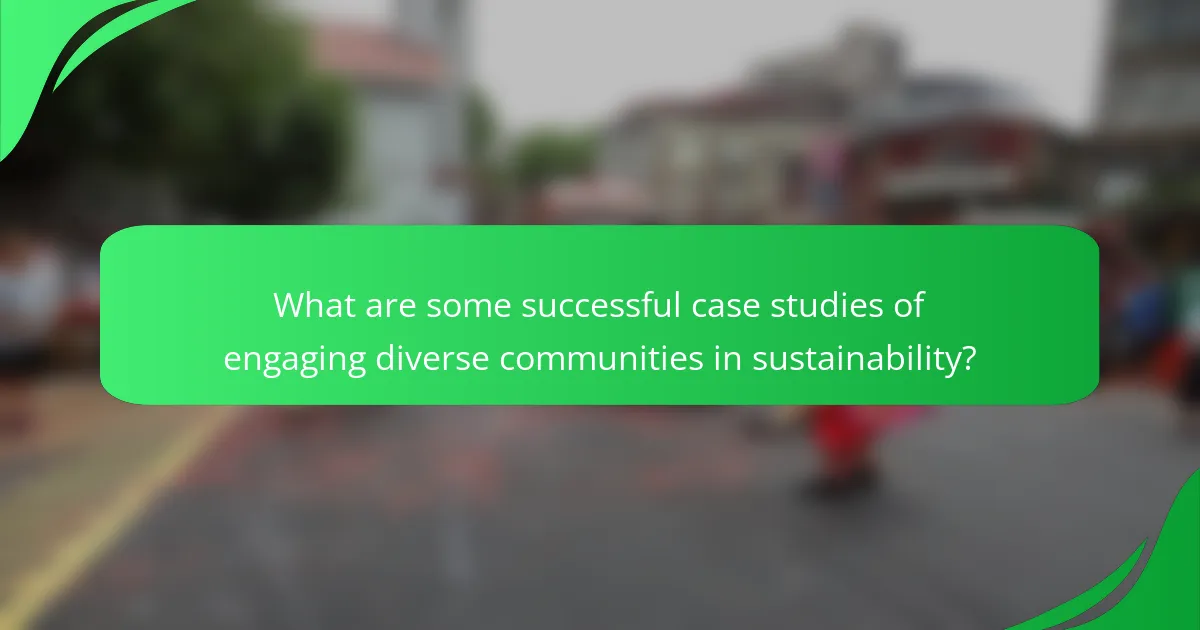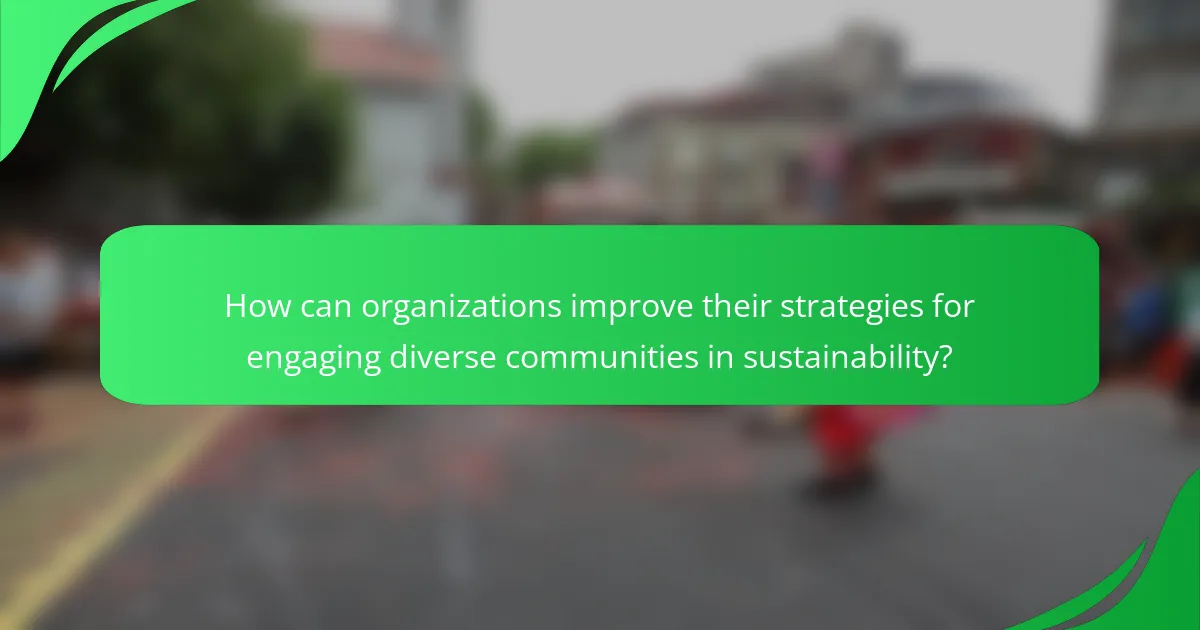The article focuses on strategies for engaging diverse communities in sustainability efforts, highlighting key approaches such as fostering inclusive dialogue, building trust, and leveraging local knowledge. It discusses the importance of community involvement in enhancing the effectiveness of sustainability initiatives and achieving equitable outcomes. Successful case studies, including the Green Neighborhoods initiative in San Francisco and the Urban Agriculture program in Detroit, illustrate the positive impact of inclusive engagement. The article emphasizes the need for organizations to actively listen to community needs, tailor communication, and establish partnerships to improve participation rates in sustainability programs. Data supports the effectiveness of these inclusive strategies in driving community engagement in environmental conservation efforts.

What are the key strategies for engaging diverse communities in sustainability efforts?
Key strategies for engaging diverse communities in sustainability efforts include fostering inclusive dialogue, building trust, and leveraging local knowledge. Inclusive dialogue ensures all voices are heard and valued. Building trust involves establishing relationships through transparency and consistent communication. Leveraging local knowledge taps into the unique insights and practices of community members. Research shows that inclusive approaches lead to higher participation rates. A study by the National Academies of Sciences emphasizes the importance of community involvement in sustainability initiatives. Engaging diverse communities enhances the effectiveness of sustainability efforts and promotes equitable outcomes.
How can organizations identify and understand diverse community needs?
Organizations can identify and understand diverse community needs through targeted outreach and engagement strategies. They should conduct surveys and focus groups to gather direct input from community members. This approach allows organizations to capture a wide range of perspectives and experiences. Analyzing demographic data can also provide insights into specific community characteristics. Collaborating with local leaders and organizations enhances credibility and facilitates deeper connections. Additionally, organizations can utilize social media platforms to reach broader audiences and encourage participation. Evidence from successful initiatives shows that inclusive practices lead to more effective program design and implementation. For instance, the Community Engagement Toolkit by the Centers for Disease Control and Prevention emphasizes the importance of understanding community voices for effective health interventions.
What methods are effective for community assessment in sustainability initiatives?
Effective methods for community assessment in sustainability initiatives include surveys, focus groups, and participatory mapping. Surveys gather quantitative data on community perceptions and needs. Focus groups provide qualitative insights through discussions among diverse community members. Participatory mapping engages residents in visualizing local resources and challenges. These methods foster inclusive dialogue and ensure diverse voices are heard. Research indicates that involving community members enhances the relevance and effectiveness of sustainability initiatives. For example, a study by the American Planning Association highlights that community engagement leads to more successful environmental outcomes.
How can cultural competence enhance community engagement?
Cultural competence enhances community engagement by fostering understanding and respect among diverse groups. It allows individuals to communicate effectively across cultural boundaries. This understanding leads to stronger relationships and trust within the community.
Research shows that culturally competent approaches increase participation in community initiatives. For example, a study by the National League of Cities found that cities employing cultural competence strategies saw a 30% increase in community event attendance.
Additionally, cultural competence helps to identify and address unique community needs. Tailored engagement strategies can lead to more effective sustainability efforts. Ultimately, this results in more inclusive and successful community outcomes.
What approaches can be employed to foster collaboration among diverse groups?
Facilitating collaboration among diverse groups can be achieved through several effective approaches. Establishing clear communication channels is vital. This ensures all members can express their ideas and concerns openly. Creating a shared vision aligns the group’s goals and fosters unity. Implementing inclusive decision-making processes empowers all participants. Providing training on cultural competence enhances understanding and respect among members. Utilizing team-building activities encourages relationship development and trust. Regular feedback mechanisms allow for continuous improvement and adaptation. Research indicates that organizations employing these strategies see increased collaboration and innovation.
How does participatory planning contribute to effective engagement?
Participatory planning enhances effective engagement by involving stakeholders in decision-making processes. This approach fosters a sense of ownership among participants. When individuals contribute their perspectives, they feel valued and invested in outcomes. Research shows that inclusive planning can improve community trust and collaboration. According to a study by the American Planning Association, communities engaged in participatory planning report higher satisfaction with local governance. This method also leads to more relevant and sustainable solutions that reflect the community’s needs. Engaging diverse voices can uncover unique insights that traditional planning may overlook. Thus, participatory planning is crucial for building effective engagement in sustainability efforts.
What role does education play in building community partnerships?
Education plays a crucial role in building community partnerships. It fosters understanding and collaboration among diverse groups. Education provides knowledge about sustainability practices and community needs. It empowers individuals to engage in local issues effectively. Educational initiatives can create shared goals among community members. Workshops, seminars, and training sessions enhance skills and awareness. Research shows that educated communities are more likely to participate in partnerships. For instance, a study by the National Environmental Education Foundation found that education increases civic engagement in environmental initiatives.
What challenges do organizations face in engaging diverse communities?
Organizations face several challenges in engaging diverse communities. One major challenge is communication barriers. Different languages and dialects can hinder effective dialogue. Additionally, cultural differences may lead to misunderstandings. Organizations often struggle to build trust with diverse groups. Historical injustices can create skepticism towards institutional efforts. Limited resources can also restrict outreach initiatives. Furthermore, organizations may lack representation within their teams. This can result in a disconnect from the communities they aim to serve. Lastly, organizations may face difficulties in tailoring their messages to resonate with diverse audiences.
How can language barriers impact sustainability efforts?
Language barriers can significantly hinder sustainability efforts. They can prevent effective communication between stakeholders involved in sustainability initiatives. This lack of communication may lead to misunderstandings about goals and strategies. Consequently, community engagement may suffer, reducing participation in sustainability programs. According to a study by the United Nations, effective communication is essential for successful environmental initiatives. Furthermore, language barriers can limit access to critical information about sustainable practices. This can result in communities not implementing eco-friendly methods. Overall, overcoming language barriers is crucial for fostering inclusive and effective sustainability efforts.
What are the common misconceptions about community engagement?
Common misconceptions about community engagement include the belief that it is solely about participation. Many think engagement only requires individuals to show up at events. In reality, effective community engagement involves building relationships and fostering dialogue. Another misconception is that engagement is a one-time event. Successful engagement is an ongoing process that adapts to community needs. Some believe that only certain community members should be involved. However, inclusive engagement encourages diverse voices for richer input. Lastly, there is a notion that engagement is easy and straightforward. In truth, it often requires significant time and resources to be meaningful.

What are some successful case studies of engaging diverse communities in sustainability?
Successful case studies of engaging diverse communities in sustainability include the Green Neighborhoods initiative in San Francisco. This program involved local residents in decision-making processes for urban greening projects. It resulted in increased community cohesion and enhanced green spaces.
Another example is the Urban Agriculture program in Detroit. This initiative transformed vacant lots into community gardens. It provided fresh produce to underserved neighborhoods and fostered community involvement.
The Solarize campaign in Portland effectively engaged diverse communities in adopting solar energy. It offered group purchasing discounts and educational workshops. This led to a significant increase in solar installations among low-income households.
Lastly, the EcoDistricts program in Portland focuses on sustainable neighborhood development. It emphasizes collaboration among residents, businesses, and local governments. This approach has led to successful sustainability projects tailored to community needs.
How have specific organizations successfully engaged diverse communities?
Specific organizations have successfully engaged diverse communities by implementing inclusive outreach strategies. They prioritize understanding community needs through surveys and focus groups. Organizations like the Sierra Club and the Nature Conservancy have tailored programs that reflect local cultural values. These initiatives foster trust and collaboration between the organizations and the communities. For instance, the Sierra Club’s “Beyond Coal” campaign actively involved local leaders from diverse backgrounds. This approach resulted in increased participation in sustainability efforts. The Nature Conservancy’s partnerships with indigenous groups have led to effective conservation strategies. These examples demonstrate that tailored engagement fosters stronger community ties and enhances sustainability outcomes.
What lessons can be learned from successful sustainability initiatives?
Successful sustainability initiatives demonstrate the importance of community engagement. Engaging local stakeholders fosters collaboration and builds trust. Initiatives that prioritize inclusivity often achieve greater participation. Clear communication of goals and benefits enhances understanding and support. Data-driven approaches inform decision-making and measure impact effectively. Flexibility in strategies allows adaptation to local needs and contexts. Education and awareness campaigns empower individuals and promote sustainable practices. Finally, long-term commitment from organizations ensures sustained progress and accountability.
How do success stories influence future community engagement strategies?
Success stories significantly influence future community engagement strategies by providing tangible examples of effective practices. They showcase what has worked, inspiring confidence in similar initiatives. These narratives help identify best practices that can be replicated in different contexts. Furthermore, they highlight the potential benefits of community involvement, motivating participation. Research indicates that communities are more likely to engage when they see successful outcomes from peers. For instance, a study by the National League of Cities found that sharing success stories increased community participation by 30%. This demonstrates the power of storytelling in fostering trust and collaboration within communities.
What metrics can be used to evaluate the success of community engagement efforts?
Metrics to evaluate the success of community engagement efforts include participation rates, feedback surveys, and social media engagement. Participation rates measure the number of individuals actively involved in initiatives. Feedback surveys assess community sentiment and satisfaction with programs. Social media engagement tracks interactions and discussions related to community efforts. These metrics provide quantitative and qualitative insights into the effectiveness of engagement strategies. For instance, a study by the National Community Engagement Network found that increased participation correlates with higher community satisfaction levels.
How can qualitative feedback enhance understanding of community impact?
Qualitative feedback enhances understanding of community impact by providing in-depth insights into community experiences. It captures the nuances of individual and collective perceptions. This feedback reveals the emotional and social dimensions of community interactions. Surveys and interviews often yield rich narratives that highlight specific needs and concerns. For example, a study by the Stanford Social Innovation Review found that qualitative data can uncover hidden barriers to engagement. This can lead to more tailored sustainability initiatives. Furthermore, qualitative feedback can inform decision-making processes by illustrating the effectiveness of existing programs. Such insights help organizations adapt their strategies to better serve diverse community needs.
What quantitative measures are effective in assessing engagement outcomes?
Effective quantitative measures for assessing engagement outcomes include surveys, participation rates, and social media analytics. Surveys provide direct feedback on community perceptions and satisfaction levels. Participation rates track the number of individuals involved in sustainability initiatives. Social media analytics measure the reach and interactions of engagement campaigns. Each measure offers specific insights into community involvement and effectiveness. For instance, a study by the National Community Engagement Coalition found that projects with higher participation rates correlated with increased community awareness and support for sustainability efforts.

How can organizations improve their strategies for engaging diverse communities in sustainability?
Organizations can improve their strategies for engaging diverse communities in sustainability by fostering inclusive dialogue and collaboration. This involves actively listening to the needs and perspectives of various community members. Engaging local leaders can enhance trust and credibility in sustainability initiatives. Organizations should also tailor their communication to reflect cultural values and practices. Providing education and resources in accessible formats can empower community members. Establishing partnerships with local organizations can broaden outreach and impact. Data shows that inclusive strategies lead to higher participation rates in sustainability programs. For example, the National Oceanic and Atmospheric Administration found that community-driven approaches significantly increased engagement in environmental conservation efforts.
What best practices should organizations adopt for effective engagement?
Organizations should adopt inclusive communication strategies for effective engagement. This involves actively listening to community feedback. Providing clear and accessible information is essential. Organizations should also build trust through transparency. Collaborating with local leaders enhances credibility. Regularly evaluating engagement efforts ensures continuous improvement. Utilizing diverse platforms increases reach and participation. Training staff on cultural competency fosters respectful interactions.
How can continuous feedback loops improve sustainability initiatives?
Continuous feedback loops can significantly enhance sustainability initiatives by fostering adaptive management. These loops allow organizations to regularly assess their practices and outcomes. Feedback from stakeholders can identify areas for improvement. This real-time information helps adjust strategies to better meet sustainability goals. Research shows that initiatives with continuous feedback mechanisms see higher engagement levels. According to a study by the National Renewable Energy Laboratory, projects that incorporated stakeholder feedback improved energy efficiency by up to 20%. By integrating feedback, organizations can build trust and collaboration within diverse communities. This leads to more effective and inclusive sustainability efforts.
What role does community empowerment play in sustaining engagement?
Community empowerment plays a critical role in sustaining engagement. It fosters a sense of ownership among community members. When individuals feel empowered, they are more likely to participate actively. Empowered communities often exhibit higher levels of collaboration and trust. This leads to more effective communication and shared decision-making. Research shows that empowered communities can achieve greater sustainability outcomes. A study by the International Institute for Environment and Development found that community-led initiatives are more successful in long-term engagement. These initiatives often address local needs more effectively, enhancing overall commitment to sustainability efforts.
What practical tips can organizations implement to enhance community engagement?
Organizations can enhance community engagement by fostering transparent communication. Regular updates about initiatives build trust and encourage participation. Hosting community forums allows for direct feedback and input. Collaborating with local leaders strengthens ties and promotes shared goals. Providing incentives, such as rewards for participation, can motivate community involvement. Utilizing social media platforms broadens outreach and engages diverse demographics. Conducting surveys helps identify community needs and preferences. Lastly, showcasing success stories highlights the impact of community contributions, reinforcing ongoing engagement.
How can leveraging local leaders strengthen community ties?
Leveraging local leaders can strengthen community ties by fostering trust and collaboration. Local leaders often have established relationships within the community. They understand the unique needs and values of residents. Engaging these leaders can enhance participation in sustainability efforts. Research shows that communities with strong local leadership see increased civic engagement. For example, a study by the National Civic League found that local leaders improve communication and mobilize resources effectively. This leads to a more cohesive community focused on common goals. Thus, local leaders serve as vital connectors in promoting community initiatives.
What strategies can be used to maintain long-term engagement with communities?
Building trust is essential for maintaining long-term engagement with communities. Consistent communication fosters transparency and keeps community members informed. Providing opportunities for participation encourages community involvement in decision-making. Regular feedback mechanisms allow communities to express their thoughts and suggestions. Celebrating community achievements reinforces a sense of belonging and accomplishment. Offering educational resources helps communities understand sustainability efforts better. Partnering with local organizations strengthens community ties and expands outreach. Finally, adapting strategies based on community needs ensures relevance and sustained interest.
The main entity of the article is “strategies for engaging diverse communities in sustainability efforts.” This article provides a comprehensive overview of effective approaches to engage various communities in sustainability initiatives, highlighting key strategies such as fostering inclusive dialogue, building trust, and leveraging local knowledge. It discusses methods for identifying community needs, effective community assessment techniques, and the role of cultural competence in enhancing engagement. The article also addresses challenges organizations face, shares successful case studies, and outlines best practices for maintaining long-term community involvement in sustainability efforts.